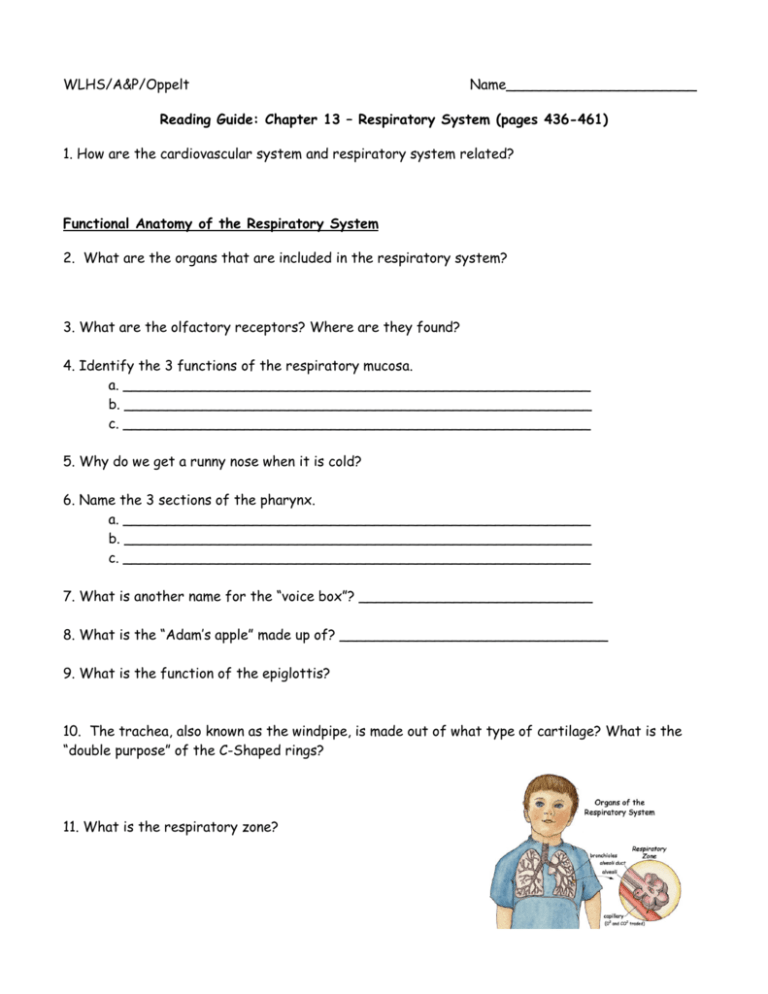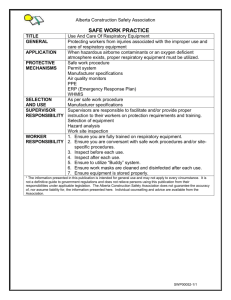(pages 436-461) 1. How are the
advertisement

WLHS/A&P/Oppelt Name______________________ Reading Guide: Chapter 13 – Respiratory System (pages 436-461) 1. How are the cardiovascular system and respiratory system related? Functional Anatomy of the Respiratory System 2. What are the organs that are included in the respiratory system? 3. What are the olfactory receptors? Where are they found? 4. Identify the 3 functions of the respiratory mucosa. a. ______________________________________________________ b. ______________________________________________________ c. ______________________________________________________ 5. Why do we get a runny nose when it is cold? 6. Name the 3 sections of the pharynx. a. ______________________________________________________ b. ______________________________________________________ c. ______________________________________________________ 7. What is another name for the “voice box”? ___________________________ 8. What is the “Adam’s apple” made up of? _______________________________ 9. What is the function of the epiglottis? 10. The trachea, also known as the windpipe, is made out of what type of cartilage? What is the “double purpose” of the C-Shaped rings? 11. What is the respiratory zone? 12. In the diagram in to the right, identify the following parts to the upper respiratory system. Nasal Cavity Nostril Laryngopharynx Oropharynx Esophagus Nasopharynx Epiglottis Larynx Tonsil Trachea 13. In the diagram below, identify the following parts of the lower respiratory tract. Trachea Bronchi Terminal bronchiole Alveoli Alveolar duct Respiratory bronchioles 14. a. How does gas exchange occur in the respiratory membrane (i.e. what process)? ______________________ b. How much gas exchange surface has been estimated to be in a healthy man’s alveolar walls? _________________________ c. Which is how much greater than the surface area of his skin? __________________ 15. a. What is the last line of defense in the respiratory system? _______________________ b. What is the role of the surfactant? _________________________________________ Respiratory Physiology 16. Describe the 4 events that are collectively called “respiration. a. b. c. d. 17. Volume changes lead to ________________ changes, which lead to the _____________________________ to equalize the pressure. 18. The air flows ___________________ during inspiration while in expiration, the air flows ______________________. 19. Describe how inspiration works. Make sure to include which muscles contract, how the thoracic cage changes, and other movements that are occurring. 20. What forces cause normal expiration? 21. Is interpleural pressure always positive or negative? _________________ What does this prevent? ______________________________________ 22. Define the following terms for lung capacity: a. Tidal volume: ________________________________________________________ b. Inspiratory reserve volume: _____________________________________________ c. Expiratory reserve volume: ______________________________________________ d. Residual volume: ______________________________________________________ e. Vital capacity: ________________________________________________________ f. Dead space volume: ____________________________________________________ 23. Why is residual volume important? _____________________________________________ 24. Identify 6 nonrespiratory air movements 25. What is the function of the phrenic and intercostal nerves? 26. Describe the difference between hypoventilation and hyperventilation. 27. What is apnea? __________________________________________________________ 28. What are 4 factors that influence respiratory rate and depth? ____________________________ ____________________________ ____________________________ ____________________________ 29. Describe the following respiratory diseases/disorders. a. emphysema: _________________________________________________________ b. cystic fibrosis: _______________________________________________________ c. Sudden infant death syndrome (SIDS): _____________________________________ 30. A Closer Look – Too Clean for Our Own Good? (page 456) a. What is asthma? ______________________________________________________ b. Over the past 20 years, by what percentage has the number of asthma cases increased? _________ c. According to the hygiene hypothesis, why has the number of allergies increased while the number of childhood diseases decreased? d. What are 2 problems with the hygiene hypothesis? 1. ______________________________________________________________ 2. _____________________________________________________________ e. What is the role of T cells within the immune system?





